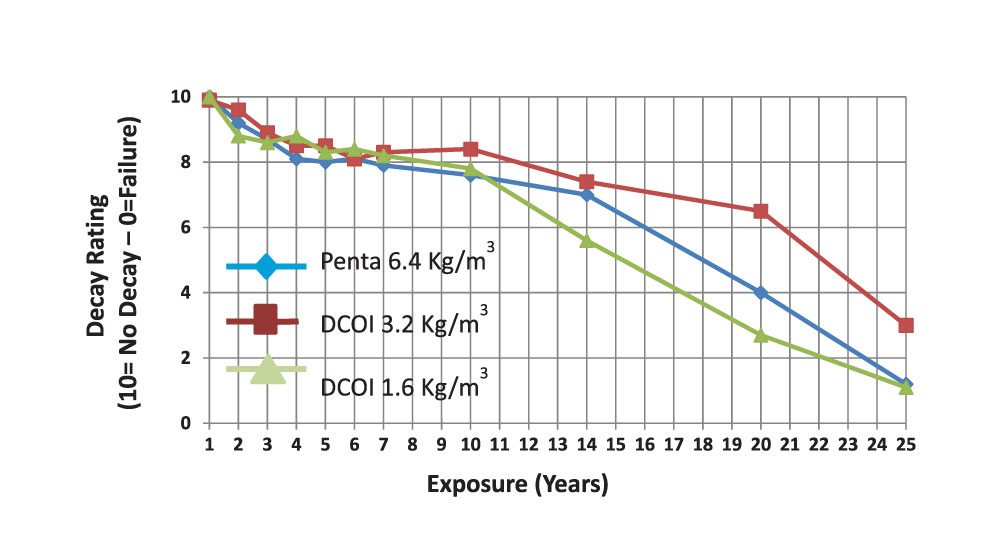Penta (Pentachlorophenol) wood preservative is a mixture of Pentachlorophenol and oil (typically an AWPA P9a oil). It’s a proven and established wood preservative that has been used for over 30 years on around 80% of poles in the USA.

As you may already be aware, the EPA (environmental protection agency) has recently banned the use of Penta due to environmental and health concerns. Because of this, many utilities in North America are now looking at alternative wood preservative options to protect their wood utility poles from decay and termite attack.
In this short article, we run through the alternatives to Pentachlorophenol and how you can use them in conjunction with a full barrier system to prevent decay, to achieve the same, if not better protection than just using Pentachlorophenol.
Alternative wood preservatives fall into two categories: water-based and oil-based.
Water-based wood preservatives such as CCA (Chromated copper arsenate) ACQ. (alkaline copper quaternary compounds) CuAz (Copper azole) and ACZA (ammoniacal copper zinc arsenate) are widely available. These wood preservatives can make the pole more challenging to climb with spiked boots as they tend to make the wood harder. They can also increase the likelihood of utility poles breaking in severe/cold weather conditions and promote pole failure when exposed to wild/bush fires.
Oil-based/water repellent wood preservatives such as Penta, creosote, copper naphthenate and more recently promoted DCOI (4,5-Dichloro-2-n-Octyl4-Isothiazolin-3-One) do not have the disadvantages of water-based wood preservatives.
With Penta being effectively banned and creosote having a similar environmental and health impact as Penta, DCOI is emerging as the preferred wood preservative to replace Penta in the North American market.
DCOI is a relatively safe wood preservative, and field testing indicates that it can be used at around half the retention level of Penta whilst giving a longer pole life span than Penta. Although historically not widely used, DCOI is now being promoted by many pole producers as the replacement for Penta wood preservative.
The following two graphs from a report published by Mississippi State University compare the decay resistance performance of Penta and DCOI at two test sites, Dorman and Saucier.
The graphs show that DCOI is effective in slowing the rate of wood decay.
The DCOI treated test stakes have a decay rating of 7.3 out of 10 after 28.5 years of exposure at the Dorman site and a decay rating of 3 out of 10 after 25 years of exposure at the far more aggressive Saucier test site.

Figure 1. Comparative AWPA (1992) E7 decay performance of field stakes treated with DCOI and penta after exposure at the Saucier test site.

Figure 2. Comparative AWPA (1992) E7 decay performance of field stakes treated with DCOI and penta after exposure at the Dorman test site.
Whilst the test data indicates that DCOI is a viable alternative to Penta, it also shows that, like all wood preservatives, DCOI loses effectiveness over time. With wood decay starting after as little as 4 years.
Field test data from Mississippi state university compares the effectiveness of Penta and DCOI in preventing wood decay (Comparative field performance of oil borne Pentachlorophenol versus the substituted isothiazolone DCOI as wood preservatives, Darrel D. Nicholas, Department of Sustainable Bioproducts, Mississippi State University, Starkville, MS, USA) demonstrating the effectiveness of DCOI compared to Penta.
Whichever your chosen preservative type, Polesaver is an ideal addition to any pole as it increases pole life by 20 years from the start regardless of wood preservative specified. You’ll see from the graph below that a full-barrier ground-line sleeve such as Polesaver +20 Protection prevents the onset of wood decay for at least 20 years, significantly increasing pole life.




This site is protected by reCAPTCHA and the Google Privacy Policy and Terms of Service apply.